|
We are very pleased to present the results of our 2023 Wellbeing Study, which was undertaken in April 2023 with 442 responses. Thank you so much if you found time to provide your input. This is our 5th study on this topic since 2018 and you can read all the results of previous studies here (scroll down through our archives). We asked you a number of questions to gauge how important Arts & Crafts are to your overall sense of wellbeing. As per our findings in previous years, there is an overwhelming sense of support that being involved in Arts & Crafts helps not only with wellbeing, but also with our sense of purpose, social connectedness, concentration levels, and our good health and activity levels. The majority, (96.8%), of respondents are aged 45+, and over 94% are women. Survey results: How important is doing Arts & Crafts to.... The average rating for sense of wellbeing was 8.8 out of 10. The majority, 49%, rated this at 10, 'Doing Arts & Crafts is essential to my wellbeing'. The average rating for sense of purpose was 8.1 out of 10. The majority, 36%, rated this as 10, 'Doing Arts & Crafts is essential to my sense of purpose'. The average score for social connectedness was 7 out of 10. The majority, 20%, rated this as 10, 'Doing Arts & Crafts is essential to my sense of social connectedness'. The average score for concentration levels was 7.8 out of 10. The majority, 28%, rated this as 'Doing Arts & Crafts is essential to maintaining my concentration levels'. The average score was 7.8 out of 10. The majority, 29%, rated this as 10, 'Doing Arts & Crafts is essential to maintaining my good health and activity levels'. On average, each participant engages in 3.46 Arts & Crafts types, with the top five favourites being:
Learning preferences continue to changeLearning preferences continue to change too. Our survey results showed that 87% of participants engage with in person (onsite) learning, and now 66% engage with online learning. These numbers add up to more than 100% because many people engage in both kinds of learning Arts & Crafts, but it shows a strong increase in online learning since our 2022 study when only 25% reported that they engaged in online learning. The main reasons given for this increase include:
We hope you find these results interesting and continue to enjoy the overall wellbeing benefits of Arts & Crafts learning with us at Ardington!
0 Comments
Our new tutor, Michael Amphlett, is a greenwood carver, practicing the art and craft of carving wooden wares, such as spoons, shrink-pots, bowls and other small items. The general craft of carving is often known by its Scandinavian name ‘slöjd’ (“sloyd”) and, in the last ten years, spoon-carving in particular has become a very popular pursuit. Teaching our keen students over this two-day weekend workshop, he enthusiastically supported each new learner to design and create their own personal brand of spoon. Who knew there were so many types!? One of the students remarked that she was less concerned with ending up with an actual spoon, because she was lost in the wonderment of the making process. 'It's meditative, it takes you out of yourself, the noises, scents and feel of the tools and the wood are a welcome antidote to modern life'. How do you start to carve a spoon? First you need to choose a piece of green (unseasoned) wood with character. All woods have different grain pattern, colour and suitability for spoon making, so look for a piece of wood where you can utilise that character to make something interesting. One student chose beech, and the piece she picked had deckchair like stripes of different coloured grain running through it. These will be positioned centrally to the bowl of the spoon. Another chose sweet chestnut because of its durability and because he wanted to get the circular grain pattern, naturally occurring in the wood, to run around the bowl of the spoon. We also had spoons in cherry, sycamore, applewood and birch, and some made from spallted wood, which has a dark colouration caused by funghi during the growing process. What are the most important tools to have? A good sharp axe is a must, and also a cross cut saw to cut into the wood to chop with the axe to. As you can see from the images, the students worked with these tools for most of the second day. Day one was axe work only when they created wooden spatulas, or butter knives. Once you have got your basic shape, then it's time to get out the spoon knives - usually a straight knife and a bent knife. The chopping block is also a must. How long does it take to make one? An expert can rough out half a dozen spoons in a day, ready for the finer work with the knives. Our students made one spoon each on day two of the workshop, in a variety of shapes and sizes! It takes years of practice however to create spoons as beautiful as those that Michael had in his collection. Some were even too precious for to him to sell, like this little collection of four small spoons all made from the same piece of wood. It's a pity they weren't for sale as I had my eye on these.... All in all, an excellent workshop with students achieving some wonderful work. We look forward to welcoming Michael back to Ardington for many more happy spoon carving workshops. To see his next available dates, you can click on the button below - we hope to see you spoon!
Observing the concentration in Alberto Atalla’s class was a joy. “Fold 1 cm in here and 1 cm in there and then iron it. Then you can top stitch. Fold over the end and stitch – you can tuck it inside or leave out. You can stitch by hand or do embellishment – it’s your design! I’ve done a zig zag in here and a zig zag in there”, he explained to the group. The students all had a think and looked again at the examples as they took control of their choices of design for this delightful wrap skirt. Who would have thought from a single set of measurements that you could make so many different skirts? Students had all cut their skirt designs without a pattern, using measurements taken earlier in the day and working directly onto the fabric. Following step by step instructions with carefully prepared samples, Alberto’s six students were on a mission to create an individually designed wrap skirt for any occasion. There were festival skirts, embellished felt wraps, long beach draping versions and dinky little Summer numbers that swirl and spin in the breeze! You could make a more formal version too – the choices were seemingly endless. And all a perfect fit of course, as the cutting element of this class meant each one was bespoke to the wearer. “What did you make your strings out of?” one asked. “Just the spare material from the main skirt body” another replied. Students talked amongst themselves showing each other how they had tackled some of the elements of the design. Others were so engrossed in the work that they ignored the lunch bell altogether! All the students made the first cut from calico – a lightweight and inexpensive material that is really easy to sew and to work with. Then they can get started on their actual designs once the pattern is a perfect fit and style. “He’s even got us doing school maths” one student confided! On the blackboard was a lovely set of calculations using Pi to get the right diameter aperture for the waist….. This was a great workshop that really got both the brain and the hands working, and all students gave Alberto EXCELLENT scores for his patient and inspiring tuition. We can’t wait for Alberto to return with his next exciting project!
In our latest wellbeing study, we asked our students to give us their views on this important topic; we send a big thank you to all of you who took time to respond. The study is our third in the series since we took over Ardington School of Crafts at the end of 2016, and showed that over 9 out of 10 (97.5%) believe Arts & Crafts improve their mental health and wellbeing. 8 out of 10 feel an enhanced sense of purpose and over 7 out of 10 (72.5%) feel their concentration levels are improved. Participants also reported improved social connectedness, activity levels, physical health and communication ability. We were also keen to understand what were people’s favourite subjects. As in previous studies, textiles and needlework, painting and drawing, calligraphy and printing came out high on the list, followed by mixed media, papercrafts, jewellery making, clay and ceramics and glasswork. We also asked about people’s experiences and preferences of doing online or onsite classes and workshops. Interestingly, more than half enjoy online learning as much or more than onsite, mainly because of the convenience to fit it in around their lifestyles. You can read all the individual comments below – they speak for themselves.
Our students cite the positive benefits of doing arts and crafts activities “Getting 'lost' in the activity - improves concentration, removes one from the pressures/horrors/etc of real life. In some cases, striking up a friendship with a like-minded person. Having been told at school I wasn't any good at art finding out that I am actually not half bad - great confidence boost. During lockdown I was even more aware of the benefits of living in the countryside as walking everyday I would look for little items a leaf a plant the colour of the sky, to inspire me as subject matter to put into a textile piece or a collage. I started to draw more and gained confidence in doing so. It gave me a sense of purpose and of joy, especially when I was pleased with the outcome. Gives a feeling of achievement and makes you feel more positive The satisfaction of learning a new skill or improving one is such a positive boost in one's self esteem and outlook. I believe that thinking about art, physically painting, drawing, on line lessons have kept me sane. Have managed a few live lessons, but during Covid art was my lifeline. On line lessons have been brilliant. As a carer I have limited time to undertake my passion for painting and embroidery so these online courses with the recording option is excellent for me and means I can pick up on a course whenever I have the time. Its been a godsend during a very stressful period. A reason to get up in the morning Joining the local quilting group, and since then becoming the chair and helping to organise talks and exhibitions has really helped me connect with my local community and has given me purpose and pleasure. Only the items I have made, some of which I have given to others. I work long hours and it gives me a time to be completely immersed in something completely different. I improved my skills level in calligraphy - having more uninterrupted sessions with more time to reflect on and finish pieces of work Being occupied, excited, trying new activities, sometime successful sometime not, socialising, listening and talking and being spoken to during the class. This is where Gemma is such an ambassador to Ardington. Helps with mindfulness Connecting with other, like-minded people. Something in the diary to look forward to. My most interesting friends are also "designer/makers" I have clinical depression, without crafts I could not function I make presents for people for Christmas and birthdays which gives me a sense of pride. I use crafting to keep my hands busy which helps me not to graze on chocolate and crisps in the evening. Also I can't worry when my hands are occupied. Helping release stress from my busy day job. The concentrated effort of Lino cutting or hand stitching is both mindful and calming Joyful moments Lifting spirits doing something creative occupying your mind with that purpose meeting new people all particularly relevant during last couple of years I’m a calligrapher and a friend is a watercolour artist, we were the busiest we’ve ever been in lockdown and didn’t want it to end. Whilst other people were so lonely and miserable, we only got a sense of it through programmes like Staged and Grayson Perry. To me, it's mindfulness. In the moment rather than dwelling on external events. Relaxation and mindfulness. Eliminates boredom The positive benefits have included feeling mentally better, with improved quality of life and tangible end products that I am proud of Its very calming to sit and stitch or to practice lettering Making and sharing Once I had set myself some craft goals as a reward for completing fuller, necessary tasks, I lost my listless lockdown syndrome Plenty to think about in the dark winter days Its being able to 'lose yourself in the craft, not thinking about anything else but that. Wanting to do and learn more” Thank you once again to all those who contributed to the research. We hope you enjoy the benefits of doing Arts & Crafts for many years to come! You can see the full results here. From Australia to America and across Europe and Asia, students collectively responded with high energy to the challenges thrown down week after week in The Brody Series. From conceptual art to Seal Script and Kufic, from textiles to metal installations, we shared techniques and skills across cultures and disciplines. Many of the students were polished calligraphers; some had done no calligraphy at all but practiced art in other media. Some joined because of their curiosity about the history of writing. Following his success in the BBC aired The Secret History of Writing, and during lockdown in the covid-19 epidemic, Brody Neuenschwander was joined by this group of diverse students for an experimental series of online workshops and ArtTalks. Ardington School shaped the programme of four workshops with Brody, designed to stretch the combined group thinking and output beyond calligraphy into ‘text art’ - for art’s sake. The sessions ran through December 2020 to February 2021. The results, in Brody’s words, were astonishing and pushed right over into the realms of art and conceptual art. In the final feedback session Brody told us that he had not seen students produce such amazing work before. This ‘Great Laboratory’ series of workshops produced such a remarkable portfolio of work that it has now been assembled into a series of three photobooks for all the students to enjoy and to be inspired by for many years to come. A downloadable montage has also been created for the students to print and frame wherever in the world they may be. We share a selection of the work, and a glimpse into the workshop content with you here, and hope you enjoy the journey we embarked upon. Session One – Conceptual art CONCEPT LEAD ART. WHAT IS THAT? ‘The choice of medium, format, and other visual aspects of work follow the decisions about the meaning, the idea, or the concept of the piece or project. Meaning can be a simple verbal statement but can also be a more intuitive sense of whatever the artist feels the need to explore’. During this first ArtTalk of the series, Brody explored how writing and text have long been considered as an art form in some cultures, and how this has evolved over the centuries. Chinese calligraphers, for example, view calligraphy as the supreme visual art in itself, more valued than painting and sculpture, and have done so since the earliest writing took shape. Brody reviewed examples of text as art from multiple cultures including some of the earliest Western works using Carolingian and Uncial from 800 BC, representing astrological (astronomical) constellations. We explored the unusual addition of freehand lines in the novel by Laurence Sterne published in 1759, where the author drew lines which were as convoluted as the twists and turns of the novel; the lines became the ‘shape’ of the story - but not in words as we know them. Brody also explored the work of more modern painters that have used text in their art, such as Andy Warhol – famous for his painting of Campbells soup cans among others. But in the main, Western art has failed to incorporate calligraphy into the sphere of fine art and we spent some time questioning why this might be. With this history and diversity as a backdrop, our throw down challenge from Session One was to create a piece of conceptual art that incorporated text and words in one or more forms. Students were given a wide brief and encouraged to use handwriting, type and calligraphy in a variety of media to express a concept. Many of the students submitted works in black and white. Some students were inspired to pick four words which told their story of corona virus, some wrote on face masks. Several students needed to improvise materials because of the lockdown and closure of their usual art suppliers. Others opted for animation and GIF files to tell the story. The results of this session showed how to give words their voice and how improvisation and good composition were key to producing successful conceptual art. A selection of student work from Session One follows below: Session Two – Comparative Calligraphy In this session, Brody gave us a behind the scenes account of the making of The Secret History of Writing. Brody examined Chinese, Latin and Arabic scripts, how they work, how they differ, and how each script made the transition to print technology. With reference to examples such as the Rosetta Stone, showing the transition from complex symbols into vowel-based language written in grid-like rows, onto traditional and simplified Chinese characters, we travelled right up to Xu Bing communicating through emojis (representing a universal language in images). Brody described the evolution of how knowledge has been captured in text form over thousands of years. The elegance and beauty of the three comparative scripts above is evident. The meaning to non-readers of Chinese, Latin or Arabic however, is incomprehensible, and leaves them to simply admire the rhythm, density and proportions of the marks on the page. In the challenge from this session, students were asked to take either Kufic lettering (the preferred Arabic script for Quran transcription) or Seal Script (Chinese characters from the second half of the 1st millennium BC) as a design concept to produce a Latin based phrase. Brody demonstrated each of the letter forms using a variety of different calligraphy tools including a cola pen, an automatic pen, and his own design, a monoline pen. One of the criteria for students to consider was the careful placement of marks - how to design a new alphabet. This was not a gestural exercise, it was more of a construction challenge. The student submissions for this challenge ranged from simple black line drawn Seal Script through to full colour psychedelic interpretations using Kufic derivatives. Students created brand new alphabets including one that took on the playful shapes of Tironian notes, a type of shorthand dating back to 60BC. Brody used computer graphics packages to edit the composition, background and colours in some of the students work and we spent time as a group discussing what impact this had on each piece. Changing the traditional Chinese red chop for turquoise was done provocatively by Brody as a reminder that we should reflect carefully on how much of a bond we want to retain with the original inspiration in our work, and how much we can take liberty to blend styles across cultures. A selection of student works from Session two follows: Session Three – Brody’s own work and the ‘medium-shift’ We lifted the lid on a whole new universe of inspiration in this final taught session of the series. Brody showed us decades worth of his medium-shift work that goes ‘off paper’ and onto skin, metal, textiles, glass, sculpture, from 2D to 3D. Brody explained that he has always been interested in the history of writing on garments. In some cultures, the writing was used as an added layer of ‘protection’ against injury, written onto garments worn underneath battle armour. The written forms slip from flat in the creation to sculptural in the wearing – a sense of movement that cannot be achieved by simply working on paper. Brody presented examples of sculpture with writing on the body from as early as 3000 BC and shared his own contemporary interpretations, using plaster made sculptures over metal armatures, covered in hand written thoughts and his own stream of consciousness. The mechanics of Brody’s medium-shift work are complex, as we found out in this session. Nibs, ink and paper are easy enough tools to get your hands on, but when you move into the realms of performance art and works of this scale, the kit list becomes less accessible. Brody showed us the moving table he designed and built, operated by a crank and special screw that enabled a static camera to film his writing in action. He showed us the heavy laser-cut metal panels that now encase a chapel, as well as the supported sculptural pieces that took weeks to hammer into shape using moulds. He also confessed that without the wonderful Thierry (his builder-engineer extraordinaire), some of these installations may never have happened. More builder than Brause, more crew than quill with these medium-shifts. And the challenge after this session was for the students to design either a metal installation for a public park (ignoring any of the usual health and safety restrictions just to make things simple!), or a kimono following a garment pattern that he supplied, or any other off-paper work that they chose. Students could submit a mock up of their design, or execute the full design. Here is a selection of submission from Session Three: This was an extraordinary series of sessions, in extraordinary times. It left me with a sense of purpose – working together with such a diverse group to create personal responses to each of the challenges and to compare, observe and learn from others work. It was a privilege to be a part of it and I’m grateful for everyone who joined us and of course, to Brody for being our guide.
The copyrights for all works in this article remain with the artists. During the lockdown, we produced a series of blogs - conversations with some of our tutors about 'How to Have a Go at Home' with various crafts. Students dived in with questions on live Facebook chats. We published the whole series at the end of May but it's nice to reflect on a few of these again now we are back. It's still great to have a go at home! Q to Karen - How did you first get into printmaking? My first proper experience of printing was at art college on my foundation course – there was a lovely new printing dept full of big scary presses and the smell of oil-based ink. I’d never really done any printing before (potato printing doesn’t count!) and this was a whole new world to me – and I loved it. I loved the process of making the plates; the unpredictability of the actual inking and printing and the fact you could make multiple copies and play with the image. I was totally hooked and tried out all sorts of techniques – I’ve never really specialised in any particular one – just weaned out those that are too messy, toxic or long-winded for my liking. Q to Karen - Can I have a go at home, and as a beginner where should I start? Which form of printing would you suggest? There are so many forms of printing and lots of them don’t need a press or a lot of specialist equipment. When I run workshops I try wherever possible to use materials and techniques that can be done at home. A lot of my materials are everyday things such as polystyrene pizza bases, juice cartons, Tiramisu containers etc (there’s a lot of eating & drinking involved in my work!). Techniques such as linoprinting, monoprinting and stamping are really easy to do at home and combine well with paint, collage and mixed media. Q to Karen - is your diet based around your need for printmaking supplies?? Definitely - I'm living on pizza and family sized tiramisu! All in the name of art of course! 😄 Q to Karen - Can you recommend a starter kit and suppliers? If you want to do something specific like linoprinting there are some good kits on the market by Essdee ranging from around £12 (very basic) to around £30. You can also buy rollers, tools and printing inks separately from a number of suppliers (listed below). For mixed media printing you can use all sorts of things – anything fairly flat that you can apply printing ink or paint to and take an impression such as foam, polystyrene, textured wallpaper, leaves etc. I use acrylic paints combined with block printing medium (to keep it wet for longer) and apply it with a sponge or roller for this. You can get most of the materials from Amazon. Specialist printing suppliers such as Handprinted.co.uk and Intaglioprintmaker.com are great and for more general supplies as well as printing materials Great Art is fantastic. They all have online and phone ordering. Q to Karen - I have been trying my hand at linocutting. I don’t have a press and I have been burnishing by hand. I have upgraded my inks, which has produced better results, but I am still finding it hard to get consistency across the whole plate. Some patchy areas even though it looks as though I have applied the ink evenly to the roller. Any tips? I do all my linoprinting by hand with a dessert spoon and use Caligo relief inks which are oil based but water soluble - they give really consistent results. Also, try different papers - Hosho is lovely to print on - hope that helps. Q to Karen - Can you recommend any good books on the subject?
The Instant Printmaker by Melvyn Petterson, Printmaking & Mixed Media by Dorit Elisha, Learning Linocut by Susan Yeates, Making Collagraphs by Susie Mackenzie – these are some of my favourites. Q to Karen - As my own work is quite expressive I would be interested in knowing which printing techniques lend themselves to this way of working For painterly expressive work monoprints are a great technique....you can be really free with them and layer up to create the desired effect. Q to Karen - Which printmakers have most influenced you and why? As far as influences - so many fantastic printmakers out there but probably Mark Hearld is my absolute favourite (the hanging bird is shamelessly influenced by him! He produces amazing prints and mixed media work, quirky and full of life and character. But there are dozens more whose work I admire. To narrow it down I’d say my favourite printmakers are Colin Moore for his stylised coastal linocuts; Anita Reynolds who walked the south-west coastal path and documented it in a series of prints, painting and drawings. Q to Karen - Do you have to be good at drawing to do this? No not really. There are lots of printmaking methods which don't require drawing skills, and you can always trace a picture too! It's not cheating, as you are making art Q to Karen - I would like to print on a prepared surface. Is watercolour or acrylic the best medium? I'd say acrylic is probably the best base to work on - it's waterproof so won't move if you need to damp the paper and you can print on it with both oil and water based inks. Q to Karen - What type of work are you doing during the lockdown? The potential to work is there but a lot of my time has been spent in the garden!! The weather has been too good to miss☺️😀. I’ve also spent a lot of time getting to grips with technology in a big way – webcams, FB, emojis, Zoom – you name it I’ve been learning it! And we know how well Karen has now done with technology - she is now running some wonderful courses for ardingtonacademy.com on printmaking! We hope you can join us on one of these and then you will know all about how to have a go at home! I went to bed very anxious the night before we went back to school this week. Simon and I were worried about everything. Worried about coming back out into the real world, worried about whether we had got the myriad of constantly changing COVID-19 precautions right, worried about our student's worries and our tutor's worries. It was not a good night's sleep, but I got up with more resolve than when I went to bed. #yougotthis I kept saying to myself. As usual, Simon's sense of humour kicked-in to lift the spirits, albeit slightly black humour today. His disturbed dreams had included one about the need to bury a dead horse on the way into work, and that his face mask had transformed into an allover body condom that came up over his head. Nice images to start the day. #yougotthis I said again. The next dilemma was what to wear. It’s been months since I was out in public or in the workplace and my wardrobe, usually full of smart work clothes, has been reduced to shorts and T-shirts for what feels like an eternity. I decided on simple lightweight trousers and layers on the top because Ardington can be draughty at the best of times but with all the doors and windows open to improve ventilation for COVID-19, it was likely to be even cooler than usual. Interestingly I haven’t worn any jewellery for 4 1/2 months either but noticed that in my dresser drawer, there were some pieces of silver clay jewellery that I had made myself at Ardington. It was comforting to put them on this morning and I left the house feeling almost human. Walking down our garden path, I noticed there were a few brown leaves and some baby conkers that had already fallen from the trees. It's now early Autumn I thought. How strange that we have missed two whole seasons at the school already this year. The last time we opened was early Spring. The seasons do seem to catch us out at Ardington. I shuddered at the thought of 'Snowgate', when in our first Winter at the school, we got stuck in snow for four hours on the A34 and couldn't open for the last day of term. It was our 25th wedding anniversary that day too! The journey to work was silent. Both of us usually have plenty to say on the way in, but this morning we just sat quietly in the relative safety of the car. I Googled that. There were 1,870 deaths on the roads in the last year, compared with over 46,000 deaths from the virus. I never thought that speeding along in the car on the A34 would be 'safe', but in absolute terms, it really was today. I felt unnerved by my heightened anxiety levels today - I of all people should know what to expect. My day job as an HR consultant means that I’m advising companies on the health, workplace and financial implications of COVID-19 on a daily basis. I've even completed a major piece of research this year with WEF on the topic. And it seems that no matter how much exercise, yoga, meditation and healthy eating I do, and despite living smoke, alcohol and caffeine free, (all good anxiety busting activities), I was still feeling super anxious today. We got to the school and opened up and there were several bunches of flowers that Simon had bought, waiting to be arranged in vases, as we usually do in the school. Anyone who knows me will understand that this is something I delight in. I set to work in earnest but still quietly. It was good to smell the flowers, and to the roses I added some honeysuckle and buddleia from the school garden for extra fragrance. Hmmm - still feeling anxious though. #youstillgotthislady! I was booked as a student on today’s course as well as being there as a director of Ardington School to experience the new procedures first-hand. Our tutor and students started to arrive and we went through our new procedures with everyone, a long speech, the new one-way system, what to expect and how to craft and move around the school safely. Compared to the usual open arms warm welcome with a basket full of freshly baked cookies, today was definitely different. However, the new 'brown-bag system' for the cookies felt friendly, nostalgic somehow in a nod-to-childhood sort of way, and the students and tutors embraced it. Small triumph #1! And the cookies were as yummy as ever, by the way. It wasn’t long before the tutor, the lovely Debbie Page, was using the new overhead desk camera, from behind her perspex screens, projecting her demo to students via the 40 inch TV screen on a table out front. Debbie was also sharing her handouts via a special Pinterest board and through email PDFs with the students. She encouraged us to Google one of her icons, Dorothy Feibleman, whose work in Nerikomi ceramic techniques is exceptional and inspired today's worksop. Luckily we had put in a new Wi-Fi mesh system at Ardington School during lockdown, and students connected super quick to access all this good stuff from Debbie. Triumph #2. Our Wi-Fi has always been erratic in the past and would never have coped! Technology upgrades seem to have accelerated everywhere - tutors, students and even Ardington's old Victorian school building are now speaking another language - techno! Debbie has always been a great tutor. Generous with her knowledge, calm, kind and supportive to the students and she started the session by giving us all a piece of white Saint Thomas clay just to handle as part of the warm-up for the session. It was cold and damp and left dirty marks on our hands - but it felt so good. Good dirt for a change – the sort of dirt that you don’t mind scrubbing your hands for. And with the cobalt and copper oxide colourants in the clay we were using, it was not just Ardington that was insisting on frequent hand-washing today! It wasn’t long before the students were fully engrossed in Debbie‘s commentary and instructions. She demonstrated three approaches to Nerikomi - 1. laminating with pieces of coloured clay and making blocks of patterns from it, 2. coiling with clay using different colours in the coils like a stick of rock, and finally 3. a marbled effect using all your off-cuts 'smushed' (technical term) together. Interestingly, my diary note-taking stopped of its own accord at this point. I was in crafting zone. On crafting time. My brain was working very differently with no wandering dark distractions. I was using different brain muscles that felt like they had been asleep for years and were just waking up! Ideas were flowing and good thoughts were flooding my head. I also felt the return of a sense of purpose. I was set on looking after our tutor and her students. How can we improve the camera set up? Is the screen in the best place? Is the one-way system working? Here, now, we could take positive action and fix things. In fact, we rolled out our 'Plan B' camera during the lunch break, as 'Plan A' camera kept timing-out. It was great to be back in control of making things better, albeit in a small way. Lunch was a delight, delivered in brown-bags with Simon‘s calligraphy and culinary skills in full flow. He labelled every one and they were filled with what the students had ordered on their menu card at the start of the day. We both knew that this was the beginning of a new tradition that we want to keep post COVID-19. No more plates of sandwiches left open on the dresser for passing germs to jump onto. And everybody got exactly what they ordered, including a few treats at the bottom of the bag. No-one at the back of the queue missing out on their first choice of lunch, or unhappy because all the scones had been snaffled! Triumph #3. This day was getting better. We took lunch into the sunny garden and everything started to feel a bit more normal now. The students started to talk together and share their own experiences and how it feels coming back to school. The afternoon workshop session was then full of chatter, just like the old days. And as for the work produced by the tutor and the students, well you can see for yourself it was an exceptionally creative workshop. Nerikomi was a great hit - we will do this again. Triumph #4. During and at the end of the school day, students used the individual sanitising kit we provided to spray tables and chairs. And when everybody had packed up and gone home, we felt a sense of immense relief. Back to school - Day One - was done and it went very well. Yes there were things we would change, including the slightly over complicated menu card and the dysfunctional camera, but there were things we decided that we will keep forever. Brown-bags for cookies, lunch and cake, the new Wi-Fi mesh system, and big screen demo's for starters.
And even though we have set up ardington academy online workshops, now managed by our daughter Gemma who joined us on 1st August, I also concluded that there’s still a lot to be said for an in-person crafting experience. There are so many sensory elements from being in a room with other crafters and an experienced tutor that you can’t get online. You can see, hear, feel, smell and touch as well as understand from other students how to hone a technique or improve your own work. OK - yes, you have to get up and dressed and get yourself to the school, but it's still worth it! One final thought - our feedback forms will be replaced with an online survey going forward. Small Triumph #5 – less paper and a more accurate set of analytics on how people felt about their experience so that we can continue to improve. But I did rely on old fashioned methods and asked everyone for feedback at the end of the day 'how do you feel?', 'what can we improve?' The students told us they felt very safe and comfortable, that they enjoyed the excellent course, that they were so happy to be out and crafting again, and gave us their thanks for seeing the school through the hard times and getting it back up and running. This was the biggest #Triumph of all. We felt humbled and proud, emotionally drained and even more resolved to run many more craft courses in-person, for those ready to venture out, and online for those who can't get to the school. Arts and crafts are good for the soul. They were good for mine on Tuesday and I'm 100% certain they always will be. New tutor, Clay Thompson, has plenty of experience to draw on. In his day job as a designer of trading software (user experience platform design for an investment bank), Clay commutes up to London most days and this gives him some quiet time to draw. Nearly all his drawing is currently done on the train. But this wasn’t always the case. He grew up in Canada and has been free hand drawing birds and animals since he was just 3 years old. Calgary was so cold and he used to visit the Winter Gardens - like a mini Eden project - which was full of wildlife subjects. Clay laughs and says “I felt like the strangest kid sometimes! But my Grandmother was an oil painter and when she set up an easel, I’d watch the empty white board and the chemistry she mixed up on her palette and a picture would just emerge. It was magical.” Clay spent a lot of time with his grandparents and these early influences stuck fast. Clay’s design career started when he left school and became a commercial artist and illustrator. His apprenticeship was in airbrushing and began in 1987. These were the days of real paint, not digital airbrushing. Macs were really expensive back then and there was no such thing as Photoshop. He spent most of his time drawing and preparing illustrations, and then moved into a visualisation role. Basically this means if you are producing a new product, Clay would sketch out what the physical thing might look like. You might just recognise some of his amazing work in the following images: He also designed the 2002 World Cup corporate marks, seen by about 4 billion people for the Korea Japan FIFA world Cup. Clay worked on these images for about a year in total, which started 3 years ahead of the world cup. Clay now mentors many young designers, and teaches drawing to groups of colleagues at work. His approach is relaxed and supportive. “You have to get people comfortable with just making marks. There is no judgement in art in my view. What people think has little relevance to the process. For me it’s more about how does this make me feel when I am doing it. I’m all for getting people to enjoy the process. The destination is not the main event – drawing is about answering questions – how do I make this 3D thing 2D? It’s also a form of meditation and a way to switch off while I’m commuting.” His work is now mostly in graphite (pencil), and this is how he will be teaching his first course at Ardington in September 2020. Clay uses a Derwent mechanical pencil, (0.5mm) and works in layers, laying down all the tonal layers first and then uses a putty rubber to remove and lift off the highlights. Then he goes back in for the detail. There are maybe three layers in total and he works across the whole piece rather than being too systematic. Interestingly, Clay works mostly from memory, simply laying down some negative space at the start from reference material and then the rest comes from his memory of the original detailed observation. You can see just how fine is the detail achieved in some of his latest work below: What’s next for Clay?
“I want to do something with my art – I’m aiming at being more commercial. When it’s your day job, the joy can go out of the discipline. But I’m now enjoying drawing every day and it’s on my terms – doing subjects that I love. I would like to do a series of British wildlife as there are so many amazing British animals that people don’t get to see. It would be great to do a collection and start selling them.” If you would like to draw on Clay’s experience as an artist, illustrator and designer, we are delighted to invite you to sign up for his class – simply click the button below to read all about his upcoming two day workshop. For the third year running, our Wellbeing Study shows the beneficial effects of being involved in arts and crafts. The majority of respondents were women again, but we are gradually increasing the number of men who participate in workshops at the school. The word is getting out that it's cool! The key results show a continued high rating for the 'feel good' factors of being creative:
Once again, many respondents submitted personal comments to evidence their scores in the above section, and we have included a number of these quotes below (anonymous).
You can access the full results of the survey at the link below, and we thank you if you were one of the participants. Here's to another year of creative calm and wellbeing! The grinding machine is just about to be started. “There’s water in the tray” Nicola explains, “use the grey part of the grinder, where you can see the water bubbling away as it spins”. The grinding wheel is not sharp as Nicola demonstrates by using it to file her nail and then puts her finger on it to show the students not to be afraid.
Grinding wheels and glass don’t immediately sound ‘cuddly’ in my experience but in glass work techniques, Nicola makes the tools and materials approachable, and works confidently to reassure those who are new to this craft. The machine has a safety screen and the cold water keeps things cool and dust free. Nicola shows her students how to grind nano-slices from the edges of their glass jigsaw pieces so that the final fit in their lead mounts and frame will be perfect. The students follow suit – growing in confidence as they feel their way with new tools. There are sparkling pieces of orange, red, yellow, turquoise and purple glass taking their turns on the grinder. |
Blog categories
All
Author:
|






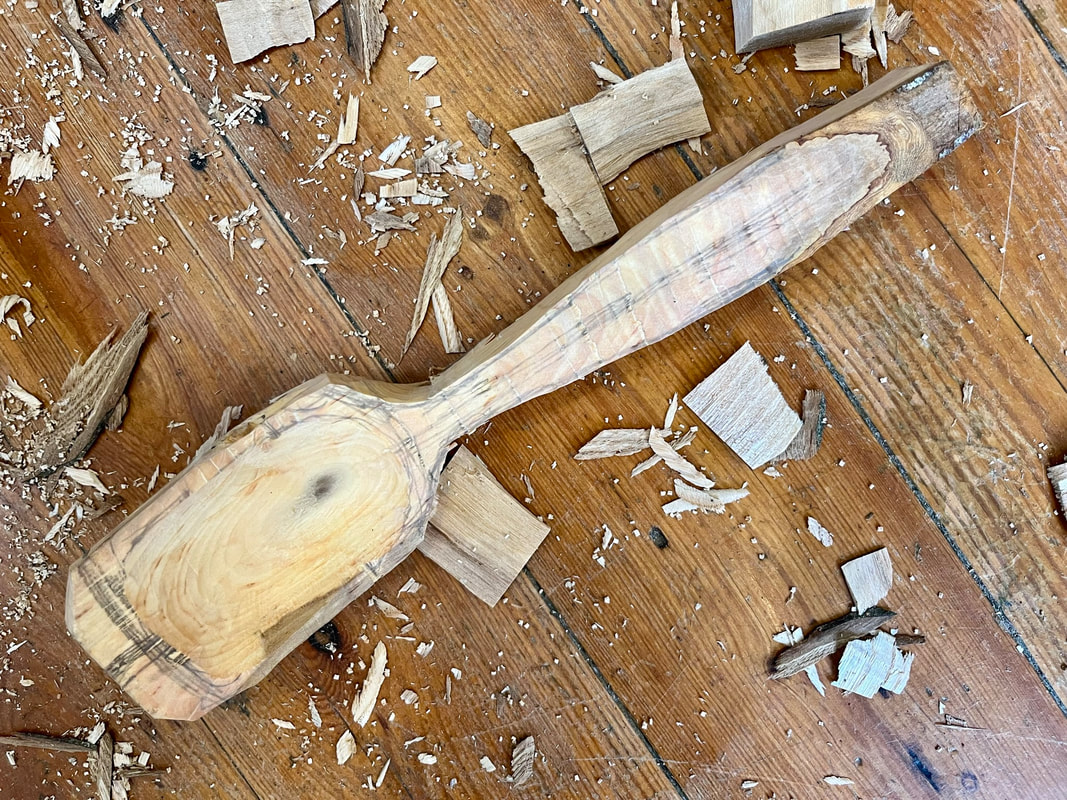
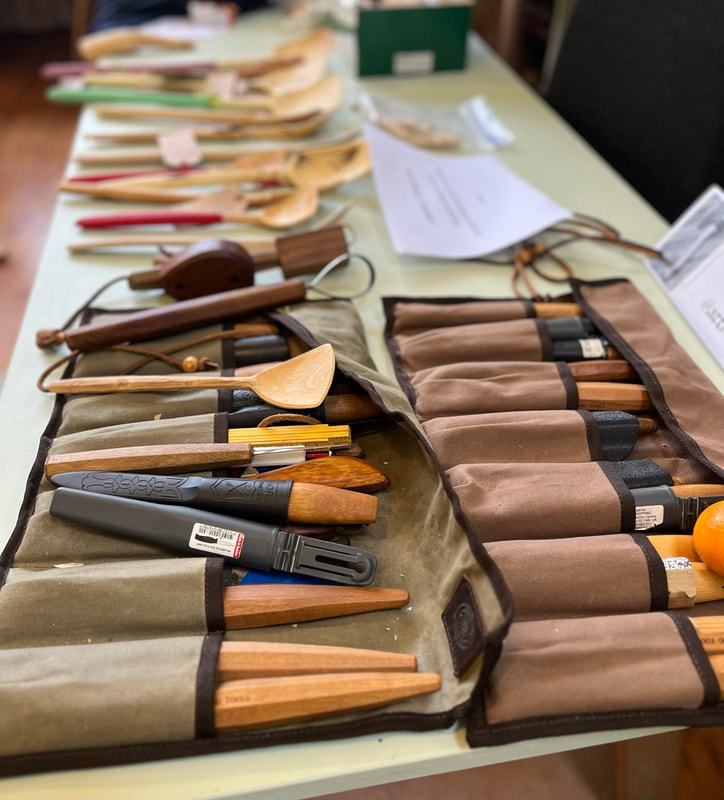

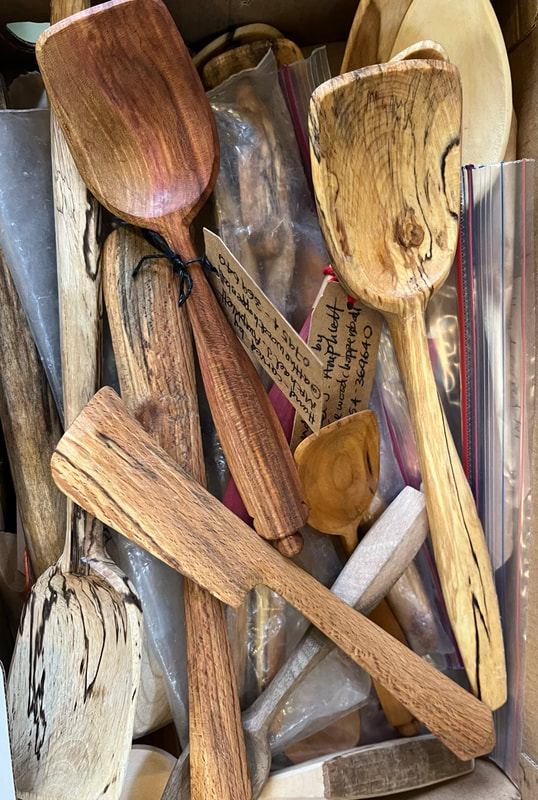

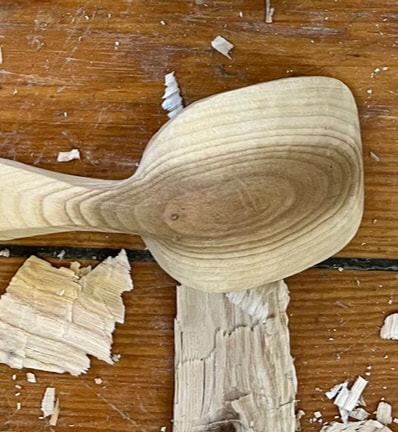







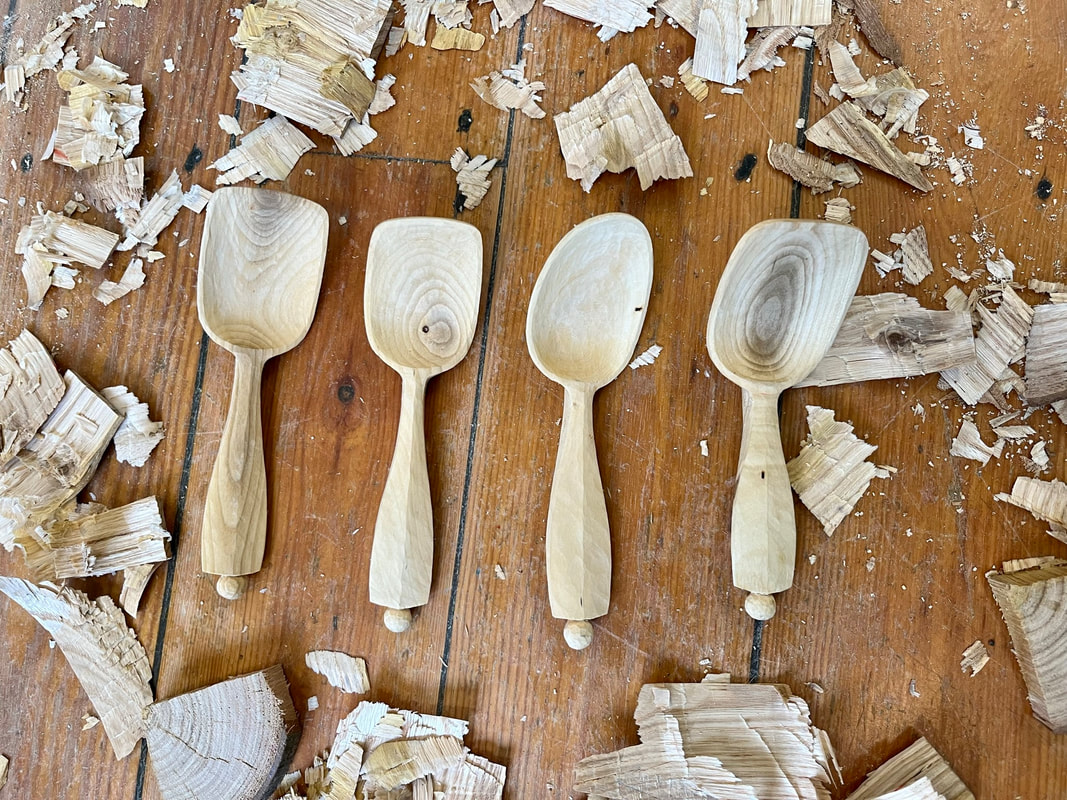










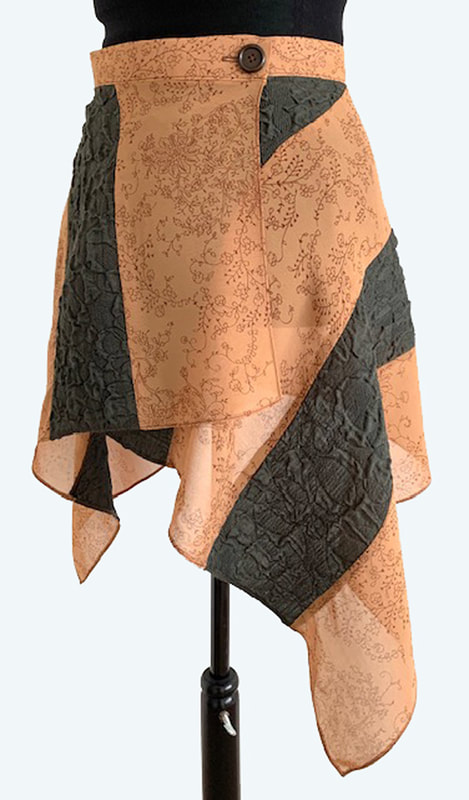






















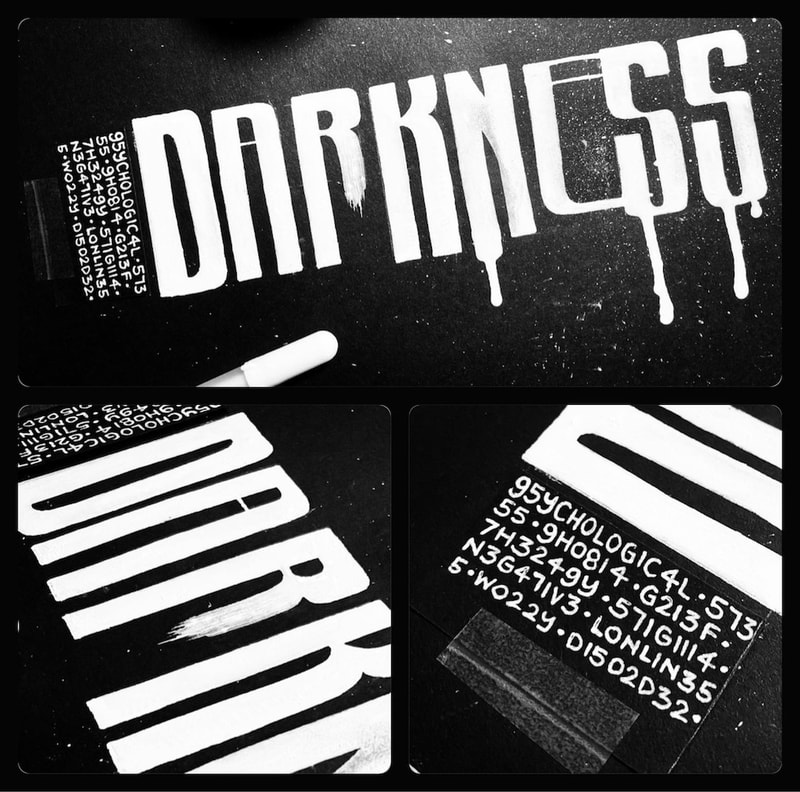








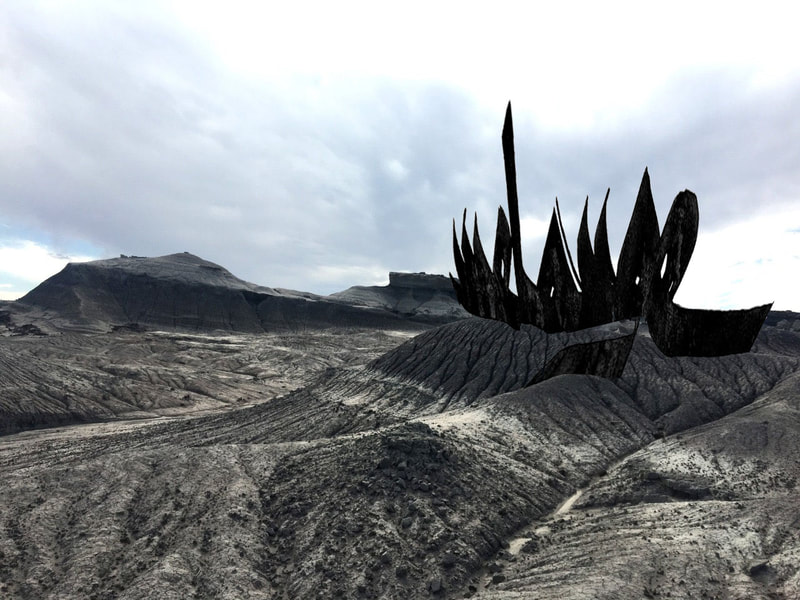




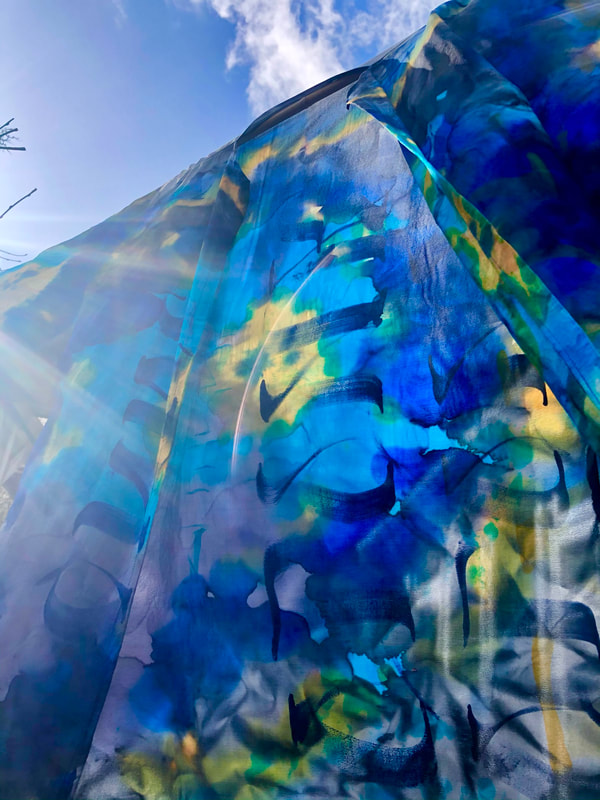













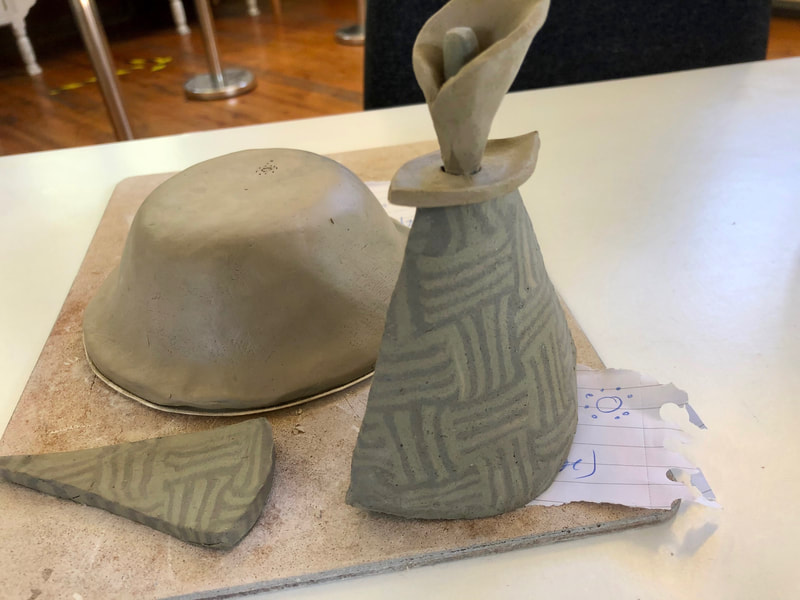










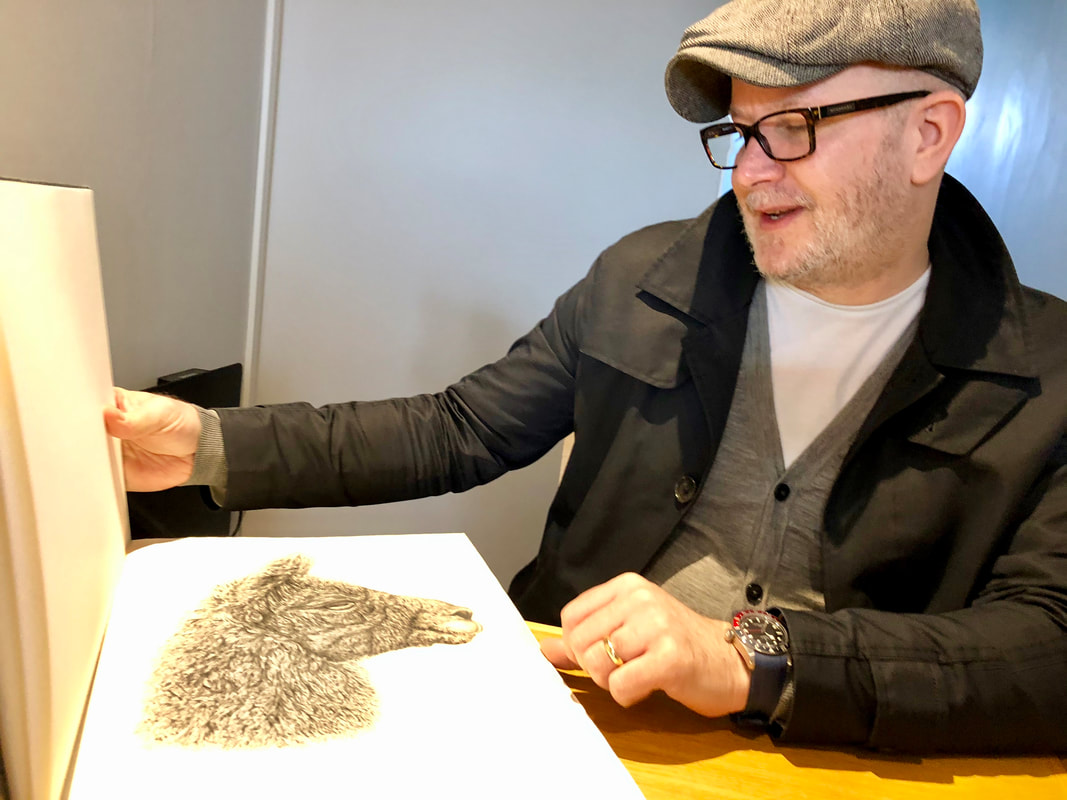
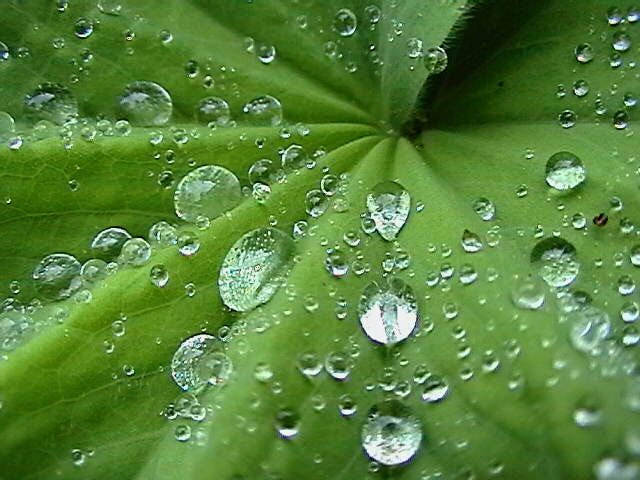




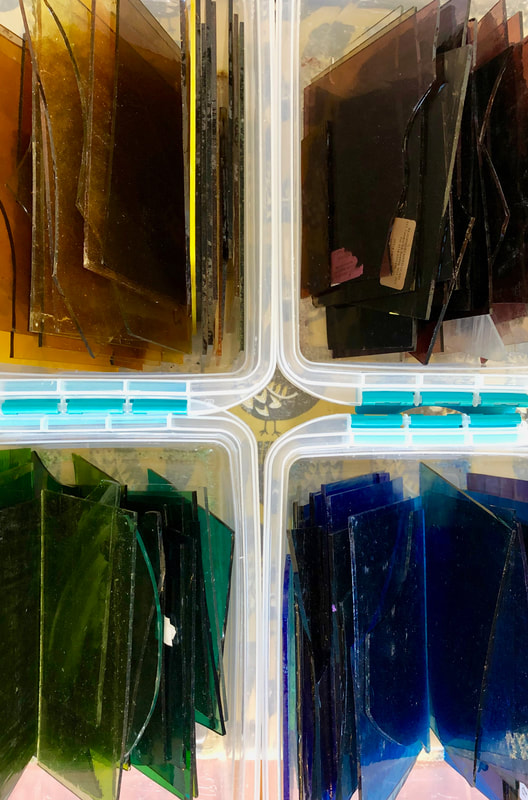
 RSS Feed
RSS Feed